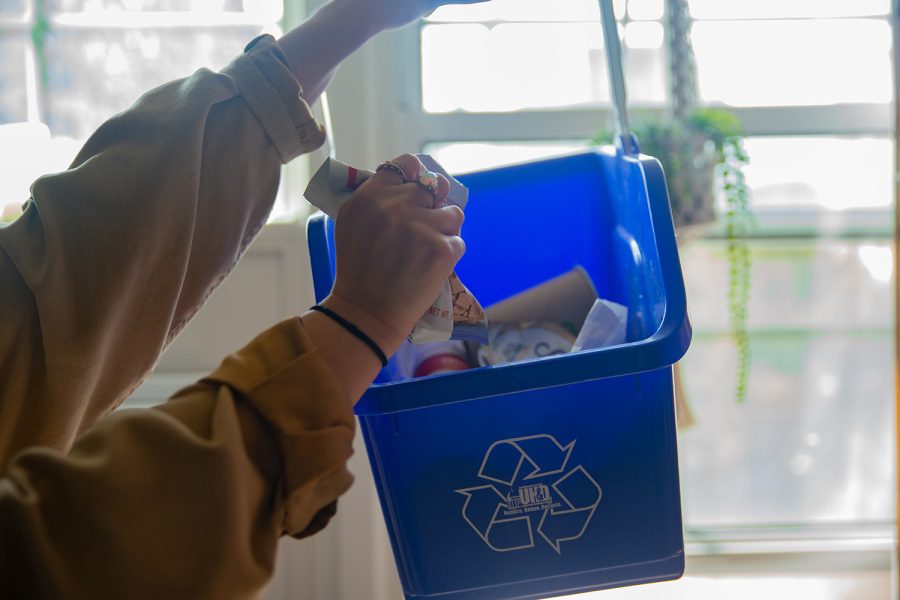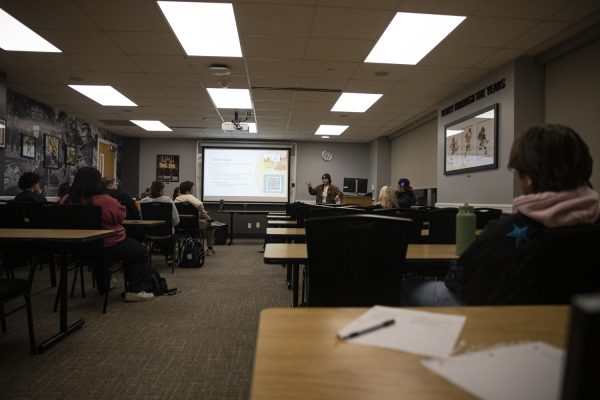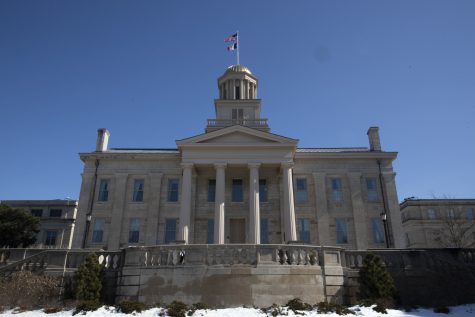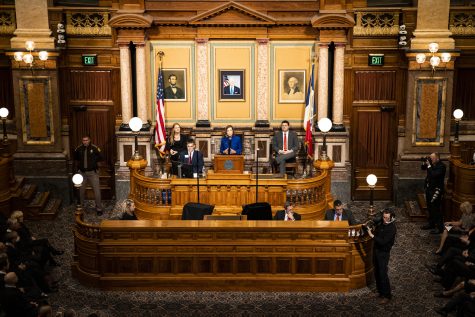Editorial | Investing in a sustainable future
As we celebrate Earth Day, the DI Editorial Board analyzes the University of Iowa’s climate action goals and ways it can improve.
Photo illustration of an individual recycling.
April 21, 2022
April 22 is Earth Day.
As the climate crisis continuously reminds us, the future of our planet is more fragile than ever before. We need to protect our planet, and our actions must go beyond Earth Day.
The University of Iowa has implemented several positive initiatives and goals to minimize its environmental impact, but our progress is not yet enough. The UI must continue its path of sustainability and environmental protection to truly do its part and set a strong example for others to do the same.
First, a look back
On Earth Day, 14 years ago, former UI President Sally Mason gave a visionary speech about the future of sustainability.
“Sustainability must and will become a central priority of all aspects of our university enterprise — our operations, our academic mission, and our responsibilities to the greater society,” Mason said.
The speech introduced a set of seven goals for the university to meet by 2020, including decreased waste production, net-negative energy growth, and more student sustainability opportunities.
In November 2019, the office of former UI President Bruce Harreld released the university’s sustainability goal framework for 2030. This list contains six framework objectives, including reducing 50 percent of greenhouse gas emissions from its 2010 baseline, expanding its sustainability research, scholarship, and solutions opportunities, and growing sustainability outreach and engagement.
In addition to its sustainability goals, the UI announced it will be coal-free by 2025 by transitioning to biomass and other renewable energy sources.
The UI has also grown its sustainability curriculum, offering more than 400 classes that teach sustainability topics. The university has created majors and programs with a focus on sustainability, including global health studies, social justice, and environmental policy, and planning.
The UI has demonstrated its commitment to sustainability, and for that, we commend the institution. But we need to do more.
As a result of the climate crisis, extreme weather has hurt Iowa communities. This includes the 2020 derecho, an abnormal tornado season, and freezing temperatures. While the UI has made impressive progress in becoming a more sustainable and eco-conscious campus, there is more work to be done.
The Road to Improvement
Our university still has work to do.
The UI failed to hit its target waste reduction goal in 2020. Its campus and health care system produced 19 million pounds in waste in 2019, but that measurement only represents hazardous waste, recycling, and composting bins on UI property.
According to the UI’s 2020 sustainability targets, the university wanted to reduce 60 percent of campus waste by 2020. Instead of reducing waste, the amount of organic waste diverted to the Iowa City Landfill and Recycling Center grew 14 times over.
In the UI 2030 Sustainability Goals framework, however, there is no specific goal for reducing campus waste. While waste reduction can certainly fall under “institutionalize and embed sustainability into campus culture” or “use campus as a ‘living laboratory’ for sustainability and education,” it’s important that we call greater attention to the effects of our waste habits.
Worldwide, humans dump 2.12 billion tons of waste every year, and excessive waste can contribute to problems like methane emissions and dangerous levels of carbon dioxide that heat up our planet. It’s up to us — and the university — to take initiative in lessening our excessive waste contributions whether it’s by reducing, reusing, and recycling, or using reusable products such as cups, grocery bags, and utensils.
Additionally, our campus is still leaving an environmental footprint with its energy use. In 2003, the UI started to explore alternatives for coal to fuel boilers in the power plant. Currently, the university has turned to biomass — a renewable organic material that comes from plants and animals.
In 2030, the university hopes to reduce greenhouse gas emissions by 50 percent compared to 2010. While biomass is cleaner than gas or coal, it still produces harmful emissions into the environment.
But the structure of the power plant that was built about 100 years ago isn’t equipped to run on solar or wind-power energy.
While hitting zero coal by 2025 is a crucial goal that will help the environment, a question that the UI should consider is looking for other ways to electrify campus, such as renovating buildings or planning to take new buildings off the steam.
Editorials reflect the majority opinion of the DI Editorial Board and not the opinion of the publisher, Student Publications Inc., or the University of Iowa.
Editorial board members are Caleb McCullough, Rylee Wilson, Josie Fischels, Hannah Pinski, Sophia Meador, and Yassie Buchanan.














